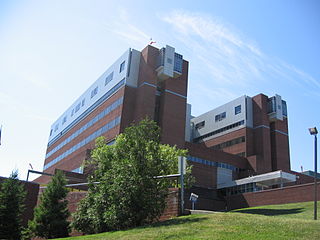The Emergency Medical Treatment and Active Labor Act (EMTALA) is an act of the United States Congress, passed in 1986 as part of the Consolidated Omnibus Budget Reconciliation Act (COBRA). It requires hospital emergency departments that accept payments from Medicare to provide an appropriate medical screening examination (MSE) to anyone seeking treatment for a medical condition, regardless of citizenship, legal status, or ability to pay. Participating hospitals may not transfer or discharge patients needing emergency treatment except with the informed consent or stabilization of the patient or when their condition requires transfer to a hospital better equipped to administer the treatment.

An emergency department (ED), also known as an accident and emergency department (A&E), emergency room (ER), emergency ward (EW) or casualty department, is a medical treatment facility specializing in emergency medicine, the acute care of patients who present without prior appointment; either by their own means or by that of an ambulance. The emergency department is usually found in a hospital or other primary care center.
Outpatient surgery, also known as ambulatory surgery, day surgery, day case surgery, or same-day surgery, is surgery that does not require an overnight hospital stay. The term “outpatient” arises from the fact that surgery patients may enter and leave the facility on the same day. The advantages of outpatient surgery over inpatient surgery include greater convenience and reduced costs.

The David Grant USAF Medical Center (DGMC) at Travis Air Force Base in Fairfield, California, is the United States Air Force's largest medical center in the continental United States and serves military beneficiaries throughout eight western states. It is a fully accredited hospital with a National Quality Approval gold seal by the Joint Commission, and serves more than 500,000 Department of Defense and Department of Veterans Affairs Northern California Health Care System eligible beneficiaries in the immediate San Francisco–Sacramento vicinity from 17 counties covering 40,000 square miles. Originally known as Travis Air Force Base Hospital, DGMC was renamed in 1966 in honor of David Norvell Walker Grant, the first Surgeon General of the United States Army Air Corps and United States Army Air Forces.
Acute medicine is a specialty within internal medicine concerned with the immediate and early specialist management of adult patients with a wide range of medical conditions who present in hospital as emergencies. It developed in the United Kingdom in the early 2000s as a dedicated field of medicine, together with the establishment of acute medical units in numerous hospitals. Acute medicine is distinct from the broader field of emergency medicine, which is concerned with the management of all people attending the emergency department, not just those with internal medicine diagnoses.
A public hospital, or government hospital, is a hospital which is government owned and is fully funded by the government and operates solely off the money that is collected from taxpayers to fund healthcare initiatives. In some countries, this type of hospital provides medical care free of charge to patients, covering expenses and wages by government reimbursement.

Norwalk Hospital is a not-for-profit, acute care community teaching hospital in the Hospital Hill section of Norwalk, Connecticut. The hospital serves a population of 250,000 in lower Fairfield County, Connecticut. The 366-bed hospital has more than 500 physicians on its active medical staff, and 2,000 health professionals and support personnel. The hospital was part of the Western Connecticut Health Network, which included two other hospitals - Danbury Hospital and New Milford Hospital - up until April 2019, when WCHN merged with Health Quest to form Nuvance Health.

Adventist HealthCare Shady Grove Medical Center is a 266-licensed bed acute care facility located in Rockville, Maryland. Shady Grove Medical Center provides a range of health services to the community such as high-risk obstetrical care, cardiac and vascular care, oncology services, orthopedic care, surgical services and pediatric care. Opened in 1979 as Shady Grove Adventist Hospital, Shady Grove Medical Center operates as part of Adventist HealthCare, a health-care delivery system that includes hospitals, home health agencies and other health-care services. Adventist HealthCare is headquartered in Gaithersburg, Maryland.

British Columbia Children's Hospital is a medical facility located in Vancouver, British Columbia, and is an agency of the Provincial Health Services Authority. It specializes in health care for patients from birth to 16 years of age. It is also a teaching and research facility for children's medicine. The hospital includes the Sunny Hill Health Centre, which provides specialized services to children and youth with developmental disabilities aged birth to 18 years.

Arrowhead Regional Medical Center (ARMC) is a teaching hospital located in Colton, California, within Southern California's Inland Empire. ARMC is owned and operated by the County of San Bernardino. The emergency department (ED) at ARMC is the second busiest ED in the state of California. The hospital operates ten different residency training programs.

University of Missouri Health Care is an American academic health system located in Columbia, Missouri. It is owned by the University of Missouri System. University of Missouri Health System includes five hospitals: University Hospital, Ellis Fischel Cancer Center, Missouri Orthopedic Institute and University of Missouri Women's and Children's Hospital — all of which are located in Columbia. It's affiliated with Capital Region Medical Center in Jefferson City, Missouri. It also includes more than 60 primary and specialty-care clinics and the University Physicians medical group.
Spartanburg Regional Healthcare System(SRHS) is one of South Carolina's largest healthcare systems. SRHS draws patients primarily from the areas of Spartanburg, Cherokee, Union and Greenville counties, located in the Piedmont region of South Carolina, and Rutherford and Polk counties, located in western North Carolina. Spartanburg General Hospital was organized under the authority of the South Carolina General Assembly in 1917, and officially became the Spartanburg Regional Health Services District, Inc., a political subdivision of the State of South Carolina, by charter granted by the secretary of state of South Carolina on May 1, 1995.
MedStar Health is a not-for-profit healthcare organization. It operates more than 120 entities, including ten hospitals in the Baltimore–Washington metropolitan area of the United States. In 2011 it was ranked as the employer with the largest number of local employees in the region.
St. Cloud Hospital is a hospital in St. Cloud, Minnesota, United States. It is a Catholic-affiliated, not-for-profit institution and part of the CentraCare Health System. The hospital has more than 9,000 employees, 400 physicians and 1,200 volunteers. It serves 690,000 people in a 12-county area.
Inpatient care is the care of patients whose condition requires admission to a hospital. Progress in modern medicine and the advent of comprehensive out-patient clinics ensure that patients are only admitted to a hospital when they are extremely ill or have severe physical trauma.

A hospital is a health care institution providing patient treatment with specialized health science and auxiliary healthcare staff and medical equipment. The best-known type of hospital is the general hospital, which typically has an emergency department to treat urgent health problems ranging from fire and accident victims to a sudden illness. A district hospital typically is the major health care facility in its region, with many beds for intensive care and additional beds for patients who need long-term care. Specialized hospitals include trauma centers, rehabilitation hospitals, children's hospitals, seniors' (geriatric) hospitals, and hospitals for dealing with specific medical needs such as psychiatric treatment and certain disease categories. Specialized hospitals can help reduce health care costs compared to general hospitals. Hospitals are classified as general, specialty, or government depending on the sources of income received.
Massac Memorial Hospital is a 25-bed general medical and surgical hospital located in Metropolis, Illinois, United States. In 2011, the hospital had 1,002 admissions, 10,031 emergency department visits, and 25,365 outpatient visits.
Sentara Northern Virginia Medical Center (SNVMC) is a 183-bed, for-profit community hospital serving Prince William County and its surrounding communities. Potomac Hospital, an independent, non-profit community hospital, merged with Sentara Healthcare in December 2009 and is now known as Sentara Northern Virginia Medical Center. The SNVMC market has experienced tremendous growth since the opening of the hospital in 1972.

South Health Campus (SHC) is a large hospital in Calgary, in Alberta, Canada. It is administered by Alberta Health Services.

Palmerston Regional Hospital (PRH) is a public hospital in the outer suburbs of Darwin in the Northern Territory, Australia. It is located in Holtze, just north of the satellite city of Palmerston. It opened in 2018 as a campus of Royal Darwin Hospital (RDH), providing general medical inpatient care, rehabilitation services, elective and day surgeries to residents of Palmerston and the rural Litchfield Municipality. Staff are shared between both hospitals, as part of the Top End Health Service network.









